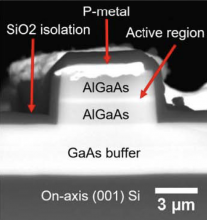
Laser gain regions using quantum dots have numerous improvements over quantum wells for photonic integration. Their atom-like density of states gives them unique gain properties that can be finely tuned by changing growth conditions. The gain bandwidth can be engineered to be broad or narrow and to emit at a wide range of wavelengths throughout the near infrared. The large energy level separation of the dot states from the surrounding material results in excellent high-temperature performance and gain recovery at sub-picosecond timescales. The fact that the quantum dots are isolated from each other and act independently at inhomogeneously broadened wavelengths results in ultralow linewidth enhancement factors, highly stable broadband mode-locked lasers, single-section mode locking, and the possibility of reduced crosstalk between amplified signals at low signal injection and enhanced four-wave mixing at high signal injection. The high carrier confinement and areal dot density provide reduced sensitivity to crystalline defects allowing for long device lifetimes even when epitaxially grown on silicon at high dislocation densities.